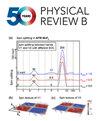由韦尔半金属费米弧表面态控制的约瑟夫森电流
IF 3.7
2区 物理与天体物理
Q1 Physics and Astronomy
引用次数: 0
摘要
本文基于 Landauer-Büttiker 公式结合非平衡格林方法,研究了超导体(SC)-Weyl 半金属-SC 约瑟夫森结混合体系的超电流。根据不同的边缘状态,费米弧被划分为三个区域:对称区、拓扑区和绝缘区,它们由方位角 θ 和横向动量 kz 定义。这里,θ 是费米弧对称轴与约瑟夫森结的法线之间的方位角。研究发现,超电流在对称区域受到抑制。在拓扑区,超级电流随 θ 的增大而增大。 由于能隙的存在,绝缘区的超级电流几乎为零。所有 kz 沟道的总超级电流随 θ 的增大先增大后减小,也就是说,θ 可以控制超级电流值。此外,磁场和方位角θ可以调整约瑟夫森结的相变,使其成为0、π或φ0结。这些特性为控制超级电流值和约瑟夫森结相变提供了研究思路,对超导电子器件的开发和应用具有重要作用。本文章由计算机程序翻译,如有差异,请以英文原文为准。

Josephson current controlled by Fermi-arc surface states of Weyl semimetals
In this paper, the supercurrent of the superconductor (SC)–Weyl semimetal–SC Josephson junction hybrid system is studied based on the Landauer-Büttiker formula combined with the nonequilibrium Green's method. According to the different edge states, the Fermi arcs are divided into three regions: the symmetric, topological, and insulated regions, which are defined by the azimuthal angle and the transverse momentum . Here, is the azimuthal angle between the symmetry axis of the Fermi arcs and the normal of the Josephson junction. It is found that the supercurrent is suppressed in the symmetric region. In the topological region, the supercurrent increases with increasing . The supercurrent is almost zero in the insulated region due to the presence of the energy gap. The total supercurrent summed over all channels increases and then decreases with increasing , that is, can control the value of the supercurrent. In addition, the magnetic field and the azimuthal angle can adjust the phase transition of the Josephson junction, allowing it to be a 0, , or junction. These properties provide research ideas for controlling the value of the supercurrent and the Josephson junction phase transition and play an important role in the development and application of superconducting electronic devices.
求助全文
通过发布文献求助,成功后即可免费获取论文全文。
去求助
来源期刊

Physical Review B
物理-物理:凝聚态物理
CiteScore
6.70
自引率
32.40%
发文量
0
审稿时长
3.0 months
期刊介绍:
Physical Review B (PRB) is the world’s largest dedicated physics journal, publishing approximately 100 new, high-quality papers each week. The most highly cited journal in condensed matter physics, PRB provides outstanding depth and breadth of coverage, combined with unrivaled context and background for ongoing research by scientists worldwide.
PRB covers the full range of condensed matter, materials physics, and related subfields, including:
-Structure and phase transitions
-Ferroelectrics and multiferroics
-Disordered systems and alloys
-Magnetism
-Superconductivity
-Electronic structure, photonics, and metamaterials
-Semiconductors and mesoscopic systems
-Surfaces, nanoscience, and two-dimensional materials
-Topological states of matter
 求助内容:
求助内容: 应助结果提醒方式:
应助结果提醒方式:


